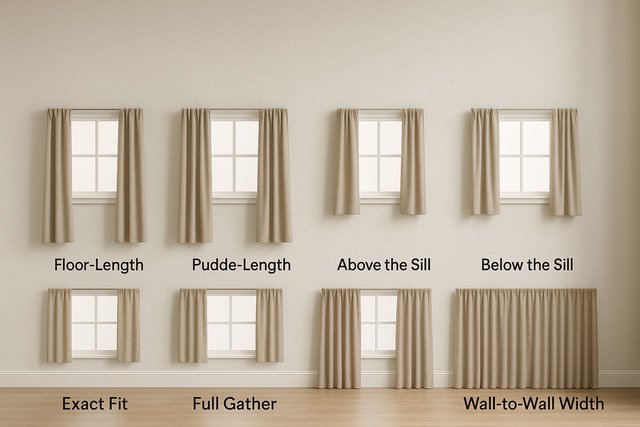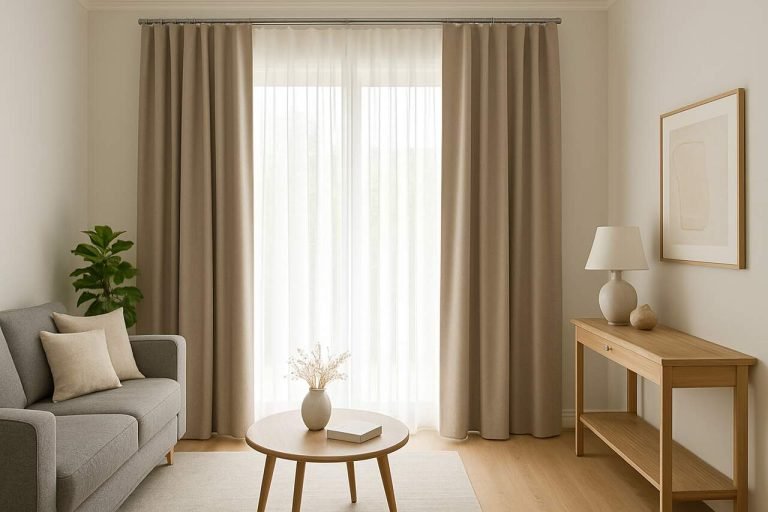Introduction
Curtains for living rooms serve as both decorative and functional elements that shape the space’s ambiance, regulate light levels, and support privacy. By selecting the right curtain materials, styles, and installations, homeowners can improve energy efficiency, reinforce interior design, and even dampen room acoustics. This article explores every essential entity associated with living room curtains from fabric options and measurements to installation techniques, care, and smart-home integrations to help users make optimized decisions for their interior spaces.
What Factors Should I Consider When Choosing Living Room Curtains?
Choosing living room curtains involves evaluating their material, size, light filtration capacity, insulation performance, and stylistic compatibility with the existing decor. Each of these attributes contributes to the curtains’ ability to transform a space both visually and functionally.
What Are the Pros and Cons of Different Curtain Fabrics (Velvet, Linen, Blackout)?
Velvet: Velvet provides excellent insulation and a luxurious look. Its thickness helps absorb sound and block light, making it ideal for formal lounges. However, it is heavy, costly, and often requires dry cleaning.
Linen: Linen adds a casual, airy aesthetic and filters light softly. It suits minimalist or Scandinavian styles but wrinkles easily and offers less privacy. It is usually dry-clean only.
Blackout Fabric: Blackout fabric is coated or layered to prevent light from entering the room. It improves sleep quality, blocks UV rays, and enhances thermal insulation. However, it may darken rooms excessively and lacks the decorative flair of lighter fabrics.
How Do Curtain Length and Width Affect Room Perception?

Curtain dimensions significantly alter how a room is perceived. Long, floor-to-ceiling curtains create height and drama, while puddled lengths evoke luxury. Wider curtains ensure sufficient fullness, promoting symmetry and softness. Incorrect dimensions result in underwhelming or disproportionate aesthetics.
| Fabric Type | Light Control | Insulation | Maintenance | Aesthetic | Best For |
| Velvet | High | High | Dry-clean | Luxurious | Formal rooms |
| Linen | Medium | Low | Dry-clean | Airy | Casual/minimalist |
| Blackout | Full | High | Machine/Dry | Plain/Utility | Media rooms, bedrooms |
Curtain fabric selection directly affects the ambiance, energy efficiency, and maintenance levels in living rooms.
How Do I Measure for the Perfect Living Room Curtains?
Correct measurements are critical for curtain functionality and visual appeal. Accurate width and height calculations influence fullness, coverage, and draping consistency, ensuring professional and polished results.
How Wide Should My Curtain Rod Extend Beyond the Window Frame?
Curtain rods should extend 4–8 inches beyond each side of the window frame. This ensures complete light blocking when the curtains are open and creates a larger window illusion. Rod extension also accommodates stack-back space the area where open curtains sit without obstructing the glass.
How Much Fullness Do I Need for an Ideal Drape?
For ideal fullness, curtain width should be 2 to 2.5 times the window width. This prevents a flat appearance and allows natural folds. For example, a 60-inch window would need 120–150 inches of combined panel width.
How Can Curtains Improve Light Control and Energy Efficiency in the Living Room?
Curtains moderate indoor temperature, enhance privacy, and regulate brightness. Depending on their material and layering, they reduce glare, retain indoor warmth, and contribute to long-term energy savings.
When Should I Choose Blackout vs Thermal-lined Curtains?
Blackout curtains block nearly all sunlight, ideal for home theaters or daytime rest. Thermal-lined curtains reduce heat loss/gain, improving energy efficiency year-round. Choose blackout for darkness and privacy; thermal lining for insulation and light moderation.
Can Sheer Curtains Still Provide Privacy During the Day?
Sheer curtains diffuse sunlight and obscure visibility into the room during daylight. While they don’t offer complete privacy at night, layering sheers with opaque panels or blinds provides both style and discretion throughout the day.
What Styles and Colors Work Best for Different Living Room Designs?
Curtain styles and colors should harmonize with room themes. Bold patterns and heavy fabrics suit traditional interiors, while light, simple designs enhance modern or minimalist aesthetics. Color choices should relate to wall paint, upholstery, and accessories.
Which Curtain Styles Complement Minimalist, Bohemian, or Traditional Décor?
● Minimalist: Linen, solid neutrals, eyelet headers, and unlined sheers promote simplicity.
● Bohemian: Layered textiles, vibrant prints, tie-dye, tassels, or macramé accents create texture.
● Traditional: Heavy drapery, pleated headers, tassel tiebacks, and damask patterns add formality.
How Do I Coordinate Curtain Color With Wall Paint and Furniture?
Use a monochromatic or complementary scheme. Light-colored curtains expand room space and match pastel or white walls. Dark hues contrast bright furnishings. Accent tones in cushions or rugs can be echoed in curtain fabric for coherence.
Which Curtain Installation Methods Are Best for Functionality and Aesthetics?
Installation methods determine curtain movement, style, and visibility of hardware. Factors include rod placement, header type, and ease of use. Motorized systems are increasingly popular for convenience and elegance.
What Are the Advantages of Motorized Versus Manual Curtain Systems?
Motorized curtains offer remote or app-based control, scheduling, and integration with smart-home ecosystems. They reduce wear from manual handling, suit high windows, and enhance security through automated open/close routines.
How Do I Choose Between Grommets, Rod-pocket, or Pinch-pleat Headers?
● Grommets: Easy sliding, modern look, visible hardware.
● Rod-pocket: Soft gathers, hides rod, limited mobility.
● Pinch-pleat: Formal, structured folds, ideal for classic interiors.
Where Can I Buy High-quality Living Room Curtains and What Should I Look for?
Look for curtain brands offering fabric transparency, lining options, customization, and installation hardware. Pricing varies by fabric quality, size, and features. Reliable retailers also provide measurement support and return flexibility.
What Price Ranges Correspond to Various Fabric Qualities and Features?
| Price Range | Fabric Types | Features | Best For |
| $20–50 | Polyester, cotton blends | Unlined, machine-made | Basic décor, rentals |
| $50–100 | Linen, blackout, thermal | Lined, better stitching | Mid-range homes |
| $100–300+ | Velvet, layered sheers | Custom sizing, premium lining | Formal or designer spaces |
Which Brands or Retailers Specialize in Durable, Stylish Curtain Options?
Popular options include West Elm, Pottery Barn, IKEA (budget), The Shade Store (custom), and Hunter Douglas (smart systems). Local drapery specialists offer personalized service, especially for unique window shapes.
How Do I Maintain and Care for My Living Room Curtains?
Proper curtain maintenance extends fabric life, preserves colors, and ensures hygiene. Care depends on fabric type, lining, and exposure to light and dust.
When Should I Machine-wash Versus Dry-clean?
Machine-wash cotton, polyester, and light sheers using gentle cycles. Dry-clean velvet, lined curtains, or delicate materials. Always consult care labels before laundering.
How Can I Prevent Fading and Maintain Fabric Integrity?
Use UV-blocking liners or back panels. Rotate curtain panels occasionally. Avoid direct sun exposure for light-sensitive fabrics. Light steam ironing helps reduce wrinkles without damaging fibers.
What Common Myths Do People Have About Living Room Curtains?
Several myths mislead users about curtain selection and usage. Understanding factual performance helps in choosing practical, stylish solutions.
Is More Fullness Always Better?
More fullness adds luxury but not always functionality. In small rooms or narrow windows, excessive fabric looks bulky. Aim for 2–2.5x window width, adjusting based on fabric weight and room proportions.
Do Blackout Curtains Make a Room Feel Darker Even During the Day?
Blackout curtains only darken rooms when closed. When layered with sheers or tied back, they maintain daylight ambiance. Choosing light-colored blackout fabrics also helps retain brightness.
Conclusion
Curtains for living rooms balance function and design, influencing lighting, energy efficiency, and ambiance. Thoughtful choices regarding fabric, measurement, and style contribute to a cohesive and efficient living space. Combining aesthetics with utility ensures curtains enhance comfort, privacy, and long-term sustainability.
FAQ’s
Curtain rods should be mounted 4–6 inches above the window frame to enhance height perception and optimize light blocking.
Curtains should be 2 to 2.5 times wider than the window frame to allow for fullness and attractive folds when drawn.
Yes, sheer curtains diffuse light while obscuring inside views. Layering with heavier drapes improves privacy without sacrificing aesthetics.
Blackout curtains block all light and UV rays. Thermal curtains provide insulation. Regular curtains filter light and serve decorative purposes.
Yes, they offer ease of use, smart-home compatibility, and better access to high or large windows, enhancing both aesthetics and practicality.
Machine-wash cotton and polyester; dry-clean velvet and lined fabrics. Always follow care label instructions and use low-heat steamers to remove wrinkles.
Yes, thermal and blackout curtains reduce heat transfer, improving energy efficiency and lowering heating and cooling costs by up to 25%.
No, blackout curtains only darken when closed. Layering with sheers and choosing light-colored fabrics ensures daytime brightness while retaining blackout benefits when needed.


